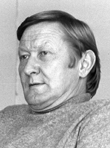
Aarno Ruusuvuori
Encyclopedia

Finland
Finland , officially the Republic of Finland, is a Nordic country situated in the Fennoscandian region of Northern Europe. It is bordered by Sweden in the west, Norway in the north and Russia in the east, while Estonia lies to its south across the Gulf of Finland.Around 5.4 million people reside...
architect
Architect
An architect is a person trained in the planning, design and oversight of the construction of buildings. To practice architecture means to offer or render services in connection with the design and construction of a building, or group of buildings and the space within the site surrounding the...
, professor
Professor
A professor is a scholarly teacher; the precise meaning of the term varies by country. Literally, professor derives from Latin as a "person who professes" being usually an expert in arts or sciences; a teacher of high rank...
and director of the Museum of Finnish Architecture. He studied at Helsinki University of Technology
Helsinki University of Technology
Aalto University School of Science and Technology , was the temporary name for Helsinki University of Technology during the process of forming the Aalto University...
, completing his studies in 1951.
Aarno Ruusuvuori was one of the central architects in Finland during the 1960s, well known for designing modern
Modernism
Modernism, in its broadest definition, is modern thought, character, or practice. More specifically, the term describes the modernist movement, its set of cultural tendencies and array of associated cultural movements, originally arising from wide-scale and far-reaching changes to Western society...
buildings, often using exposed concrete, often in a Brutalist style. His best-known works are the Weilin & Göös Print Works in Espoo
Espoo
Espoo is the second largest city and municipality in Finland. The population of the city of Espoo is . It is part of the Helsinki Metropolitan Area along with the cities of Helsinki, Vantaa, and Kauniainen. Espoo shares its eastern border with Helsinki and Vantaa, while enclosing Kauniainen....
(1964–66) and the Church of Hyvinkää
Church of Hyvinkää
Hyvinkää Church, also known as The New Church of Hyvinkää, is a modernist church located in the town of Hyvinkää, Finland. It was designed by architect Professor Aarno Ruusuvuori and built in 1961.-Description:...
(1961).
Ruusuvuori courted much controversy during the early 1970s with his ambitious plans for the modernisation of the Helsinki City Hall in the very centre of Helsinki
Helsinki
Helsinki is the capital and largest city in Finland. It is in the region of Uusimaa, located in southern Finland, on the shore of the Gulf of Finland, an arm of the Baltic Sea. The population of the city of Helsinki is , making it by far the most populous municipality in Finland. Helsinki is...
. The City Hall takes up an entire city block, consisting mostly of several buildings built in the neo-classical style, including buildings designed by C.L. Engel
Engel
Engel means angel in some non-English languages and may refer to:* "Engel" , performed by Rammstein* Engel , a 2002 role-playing game* Engel , Swedish industrial/melodic death metal band* Engel group, in mathematics...
. Ruusuvuori preserved the main festival hall, but demolished many of the interiors, preserving only their facades. This saga, together with many other developments where historical buildings were demolished was captured in an influential book by architects Vilhelm Helander
Vilhelm Helander
Arne Anders Vilhem Helander , is a Finnish architect and was Professor of Architecture History at Helsinki University of Technology, Espoo, Finland from 1986 until 2005, when he became Professor Emeritus....
and Mikael Sundman, titled Kenen Helsinki? (Whose Helsinki?) (1970). Ruusuvuori continued to work on the large scheme throughout the 1970s, completing it in 1988, but toned down the scale of the earlier proposed demolitions.
The Weilin & Göös Print Works (1964–66), Espoo, designed by Ruusuvuori, was closed down at the end of the 20th century. It was then purchased by the City of Espoo, who had it converted into the WeeGee Exhibition Centre, for culture and the arts, which opened its doors to the public in October 2006.
Key works


- Hyvinkää church, 1961.
- Merimiehenkatu 32, apartment block, Helsinki, 1962.
- Huutoniemi Church, Vaasa, 1964.
- Hämeenlinna Church, renovation, 1964.
- Weilin & Göös Print Works, Espoo, 1964–66 (converted into the WeeGee Exhibition Centre, 2006).
- Tapiola Church, Espoo, 1965.
- Roihuvuori School, Helsinki, 1967.
- Marimekko Print Works, Helsinki, 1967 (demolished).
- Mikkeli Police Station, 1968.
- Paragon office building, Helsinki, 1973.
- Sauna Bonsdorff, Padasjoki, 1987.
- Helsinki City Hall "restoration" and modernization, 1970 and 1988.
- Finnish National Museum extension (1985) (unrealised)

